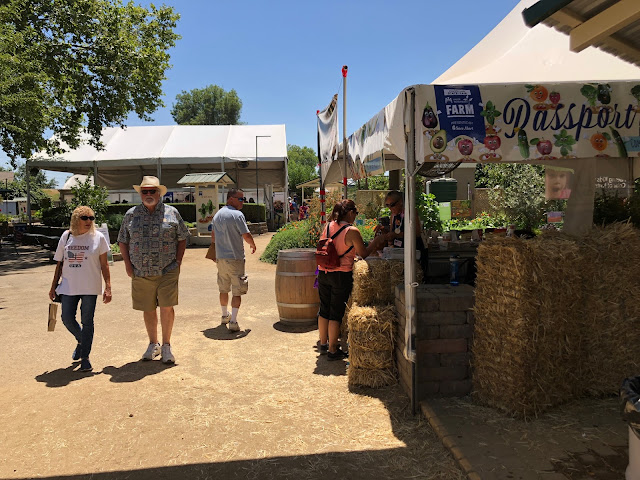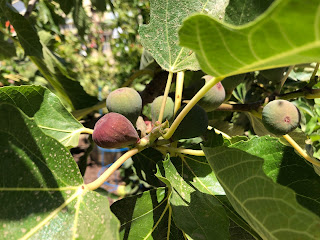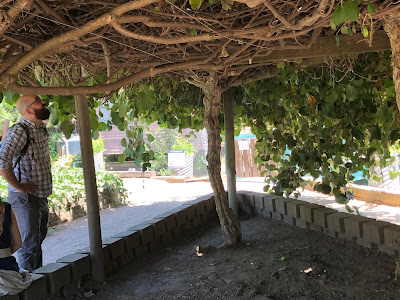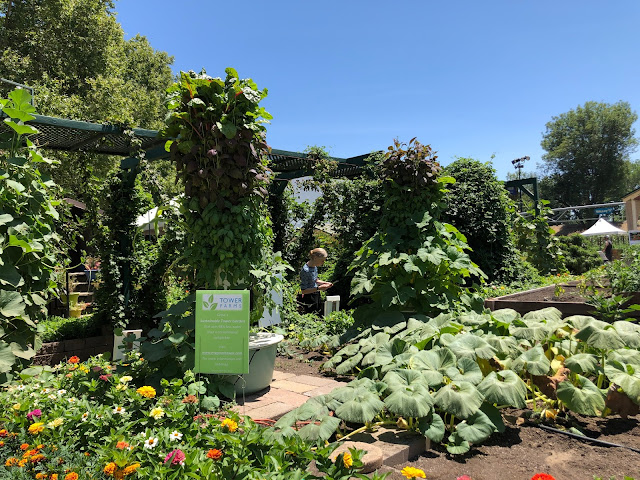
|
|
At the State Fair, pick up a map at The Farm's Passport booth, then find the stamps to earn a free piece of fresh fruit. (Photos: Kathy Morrison)
|
Learning opportunities are growing all over
Three young adult fairgoers were strolling along the back of the State Fair's Farm when one of the trio exclaimed "Tomatoes!" I was close enough to hear, and turned in the direction they were looking. Instead of a tomato vine, they were next to a dwarf nectarine tree, the purple-red side of its ripe fruit almost glistening in the midday heat.

|
|
The figs are doing well at The Farm.
|
One of the others corrected him, but it was a good reminder that not everyone knows what our fresh California produce looks like while it's growing. And that's why The Farm exists all year round, not just the two-plus weeks the State Fair is open. School tours visit in spring and fall, when kids can see up close the developing fruits and vegetables representative of the state's many crops.
During the fair's run, which concludes July 28, The Farm offers an interactive activity (and not just for kids). Pick up a map that will lead you to five stations to learn about lemons, mint, avocados, peaches and Fresno peppers. Get a stamp at each stop, bring the stamped map back to the main booth, and get a free piece of fresh fruit. (I got an apple.) On the back of the map there's a recipe for a salad using those five ingredients, plus a $5 coupon for Save Mart, which sponsors The Farm.
Great, but what is there for those of us who already know our tomato vines from our orchard trees? Well, I like to see from year to year what is planted at The Farm, how things are thriving, and whether there's anything there I would like to add to my plantings.
A few years ago, I became fascinated with the arbor of hops at The Farm. That later prompted me to grow my own hops, with some help (and a hop rhizome) from New Helvetia Brewing's
HIMBY (Hops In My Back Yard)
program. My hops aren't as extensive as the fair's, but they do cast some shade this year, which is lovely.

|
|
Look up under the kiwi trees to see their fuzzy fruit.
|
The Farm has many other learning opportunities for gardeners. Want to grow grapes? Grapevines, check. Kiwis? The interlocked kiwi trees are amazing. Figs are ripening on fig trees. There are gourds climbing trellises, and even cotton plants growing in one of the raised beds. Want to know how much space pumpkins or watermelons take up? Easy to see that here. The Farm's corn is doing well, as are the peppers, but the strawberry and blueberry plants looked a little beat-up in the heat -- they could use some shade cloth.
The demonstration garden also has several 6-foot aeroponic towers, incredible space-savers that grow herbs and vegetables with moisture forced up the towers by pressurized air. Topped by chard and basil, these looked more lush than last year -- a very impressive feature.
In another area, The Farm has a good display on planting a water-wise garden, complete with drip irrigation and mulch examples. And the Pollinator Garden is free entertainment, if you like to watch bees at work.
And I can't forget to mention the UCCE master gardeners, who staff an information booth in The Farm every day of the fair. Bring your gardening questions to these folks who are experts on growing in the Sacramento region.
My one suggestion to The Farm organizers: Put more California native plants in the landscape area, and label them as such. As much as I love "Hot Lips" salvia, which is a cultivar, I'd rather see less of that and more of a native salvia such as hummingbird sage, which is just as pretty. Natives thrive better in our climate anyway.
The State Fair is open daily through July 28 at Cal Expo,
1600 Exposition Blvd., Sacramento
. Gates open at 10 a.m. Fridays-Sundays, 11 a.m. the other weekdays. Closing time is 10 p.m., though The Farm area shuts at 6 p.m. Fair general admission is $14, but $12 for seniors, $10 for ages 5-12 and free for kids 4 and under. Parking has shot up to $15, so bring cash for that.
For more information on the fair, go to
www.castatefair.org
.

|
|
At The Farm, hop bines run along an arbor behind this raised bed, which includes a couple
of aeroponic towers, plus annual flowers and some squash plants. (That wilting
is normal in the heat, by the way.)
|



